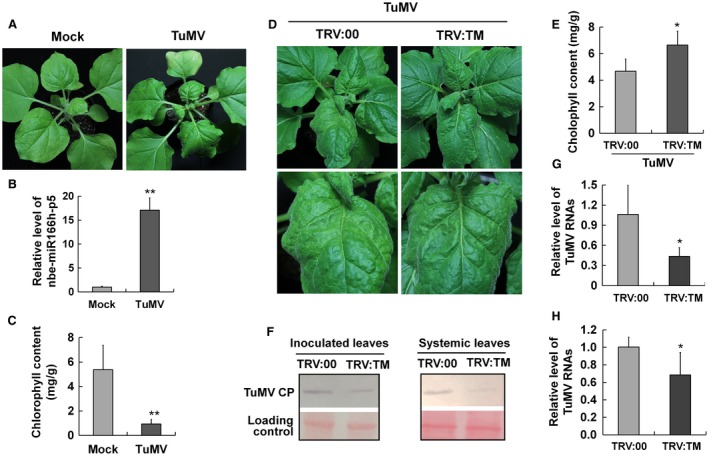Figure 4.

Suppression of nbe‐miR166h‐p5 attenuated the symptoms of Turnip mosaic virus (TuMV) on Nicotiana benthamiana and reduced viral accumulation. (A) TuMV symptoms at 8 days post‐inoculation (dpi). (B) Quantitative reverse transcription‐polymerase chain reaction (qRT‐PCR) showed the up‐regulated expression of nbe‐miR166h‐p5 in TuMV‐infected plants. (C) The chlorophyll content in TuMV‐infected leaves was significantly less than that in mock leaves. (D) TuMV was inoculated onto TRV:TM‐treated and control plants at 14 days after virus‐based microRNA (miRNA) suppression (VbMS) treatment. At 8 dpi of TuMV, the leaf yellowing symptom was mild on leaves of nbe‐miR166h‐p5‐suppressed plants compared with that on control plants. (E) The chlorophyll content in nbe‐miR166h‐p5‐suppressed leaves was significantly higher than that in control leaves. (F) Western blotting showed that TuMV accumulated at a lower level in both inoculated and systemic leaves of nbe‐miR166h‐p5‐suppressed plants. CP, coat protein. (G, H) qRT‐PCR showed that TuMV RNAs accumulated at a lower level in both inoculated leaves (G) and systemic leaves (H) of nbe‐miR166h‐p5‐suppressed plants. Bars represent the standard errors of the means. A two‐sample unequal variance directional t‐test was used to test the significance of the difference (*P < 0.05; **P < 0.01). [Colour figure can be viewed at wileyonlinelibrary.com]
